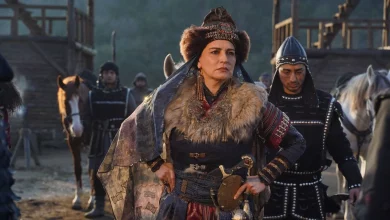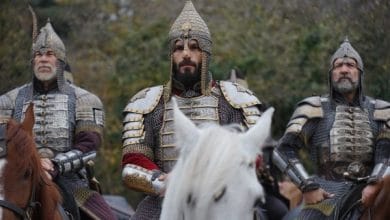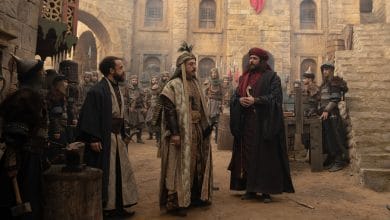
AltanGordun will join Kurulus Osman in Season 5 and play the role of Yakup Bey.
Who is Altan Gordum?
He was born in Adana on December 1, 1958. He started his undergraduate education at Ankara University Faculty of Political Sciences in 1978. He attended Ankara Art Theater courses in 1979. He worked as an actor, director, manager and instructor here until 1996. He lived in Izmir between 1996-2000. He returned to Ankara in 2000 and took part in many plays. He played the character of Panzer Hoca in the TV series Hayat Bilgisi. He was married to Vahide Perçin between 1991-2013 and has a daughter named Alize.
Filmography
1993: Goodbye Hope, 1994: Bells, 1996: Liberation, 1999: Snake Story, 2003: Life Sciences, 2006: First Love, 2007: Winds of Poplars, 2008: Love Doesn’t Say I’m Coming, 2008: Cars of the Revolution, 2011: For My Father, 2011: After the Revolution, 2011: Labyrinth, 2011: My Dear Father, 2012: Dancing with Jackals 2: We Are Sick Grandfather, 2012: Magnificent Century, 2013: Love Me Like This, 2013: Şeytan-i Racim, 2020: If Love Says Come, 2022: Once Upon a Time in Çukurova, 2022: Lone Wolf, 2023-: Establishment Osman.
Sultan Abdul Hamid II, the 34th Sultan of the Ottoman Empire, is a figure of immense historical significance. His reign, which spanned from 1876 to 1909, was marked by profound challenges and transformations both within the Ottoman Empire and on the global stage. Abdul Hamid II’s leadership, often characterized by its conservatism and authoritarianism, came at a time when the empire was confronted with internal strife, external pressures, and the specter of modernization. In this detailed examination of his life and reign, we will explore the complex legacy of Sultan Abdul Hamid II, delving into his early years, his rule, his policies, and the lasting impact of his reign on the empire and the world.
1. Early Life and Ascension to the Throne
Abdul Hamid II was born on September 21, 1842, in Istanbul, during a period of significant upheaval within the Ottoman Empire. His birth name was Mehmed Abdulhamid, and he was the son of Sultan Abdulmejid I and Tirimüjgan Kadın. His early education was carefully supervised and included subjects like Islamic theology, history, and languages. As a young prince, Abdul Hamid received a comprehensive education that prepared him for his eventual role as Sultan.
Abdul Hamid’s ascension to the throne in 1876 followed the deposition of his brother, Sultan Murad V, who was declared mentally unfit to rule after just 93 days on the throne. At the age of 34, Abdul Hamid became the Sultan, a position that came with immense power and responsibility.
2. The Reign of Abdul Hamid II
Abdul Hamid II’s reign was characterized by both challenges and innovations, and it unfolded against the backdrop of a rapidly changing world. During his time as Sultan, he implemented a range of policies and initiatives that had a profound impact on the Ottoman Empire and its subjects. Let’s explore some key aspects of his rule:
2.1. Modernization and Reforms
One of Abdul Hamid’s earliest acts as Sultan was to suspend the Ottoman Constitution, which had been established in 1876. This move effectively dissolved the nascent constitutional government, allowing him to rule with greater authority. He was known for his skepticism of European-style constitutionalism and his preference for centralized rule.
Despite his conservative leanings, Abdul Hamid recognized the need for certain reforms to strengthen the empire. He initiated efforts to modernize the military, improve infrastructure, and establish a network of telegraph lines. His aim was to maintain Ottoman sovereignty in a rapidly changing world.
2.2. The Pan-Islamic Vision
Abdul Hamid II is perhaps best known for his advocacy of the Pan-Islamic movement. He saw himself as the spiritual leader of the Muslim world and sought to unite Muslims across the globe under the Ottoman banner. To this end, he supported Islamic causes, including the construction of mosques and religious schools in various parts of the world.
One of his notable actions was the convening of the First Islamic Conference in 1889, which aimed to address issues facing the Muslim world, such as colonialism and the rights of Muslim minorities. Abdul Hamid’s Pan-Islamic vision, while not without critics, resonated with many Muslims who saw the Ottoman Sultan as a symbol of Islamic unity.
2.3. Suppression of Dissent
Abdul Hamid II’s rule was marked by a strong authoritarian streak. He clamped down on political dissent and opposition, which led to the suppression of various groups, including reformists, nationalists, and intellectuals. His methods included censorship, surveillance, and the use of a secret police force known as the “Hamidiye.”
These repressive measures were intended to maintain the stability and unity of the empire, but they also fueled discontent and resistance among his subjects. The atmosphere of fear and suspicion that permeated Ottoman society during his reign contributed to the empire’s challenges.
2.4. Armenian Question and Massacres
One of the darkest chapters of Abdul Hamid II’s reign was the Armenian Question, a term used to describe the plight of the Armenian population in the empire. The Armenian population faced discrimination and violence, and tensions between Armenians and Ottoman authorities led to a series of massacres, most notably the Hamidian Massacres of the 1890s.
Abdul Hamid’s role in these events remains a subject of historical debate. While some argue that he actively ordered and encouraged the violence against Armenians, others contend that he allowed local officials and irregular forces to carry out the atrocities. Regardless of his direct involvement, the events under his reign have left a painful legacy and are a subject of ongoing international discussion and recognition as a genocide by several countries.
2.5. Foreign Relations and Imperial Decline
Abdul Hamid II’s reign coincided with a period of significant territorial losses for the Ottoman Empire. The empire’s long-standing decline continued during his rule, as it faced challenges from European powers, particularly Russia, and nationalist movements within its territories. The loss of territories in wars with Russia and the Balkan states further weakened the empire.
His diplomatic efforts aimed at preserving Ottoman sovereignty often faced limited success. Abdul Hamid sought to balance the interests of competing European powers and avoid being drawn into conflicts, but the empire’s position continued to erode.
3. The End of the Reign
Abdul Hamid II’s rule came to an end in 1909 when a group of discontented military officers and intellectuals known as the Young Turks staged a coup. The movement, which had been advocating for constitutional reforms and greater political participation, gained widespread support.
The Sultan was deposed, and his brother, Mehmed V, was placed on the throne. Abdul Hamid II was initially placed under house arrest in the Ottoman capital, but he was later exiled to the island of Thessaloniki (now Thessaloniki, Greece), where he lived until his death in 1918.
4. Legacy and Historical Assessment
The legacy of Sultan Abdul Hamid II is a subject of historical debate and analysis. Some view him as a figure who, while authoritarian, sought to preserve the Ottoman Empire’s integrity in the face of immense challenges. His support for the Pan-Islamic movement and efforts to modernize certain aspects of the empire are seen as attempts to navigate the changing geopolitical landscape.
However, his rule is also marked by repression, violence, and a failure to address the grievances of various ethnic and religious communities within the empire. The Armenian Question and the Hamidian Massacres, in particular, cast a long shadow over his legacy and remain subjects of intense historical and political scrutiny.
In the broader context of Ottoman history, Abdul Hamid II’s reign is seen as a transitional period that bridged the empire’s traditional and modern phases. His skepticism of constitutionalism and centralized rule reflected the challenges faced by a once-mighty empire grappling with the forces of modernity and nationalism.
5. Conclusion
Sultan Abdul Hamid II’s rule encapsulated the complex and tumultuous history of the late Ottoman Empire. His leadership, marked by authoritarianism, modernization attempts, and a vision of Pan-Islamic unity, left a lasting impact on the empire and the world.





